282 posts
Latest Posts by astrotidbits-blog - Page 5
Welcome to Jupiter.
ANNOUNCER at NASA’s Jet Propulsion Laboratory in Pasadena, CA, upon the entry of the Juno spacecraft into orbit around the largest planet in the solar system. Juno, a solar-powered probe, will now conduct a 20-month investigation of the Jovian giant.
Fuck yeah human beings.
(via the Guardian)
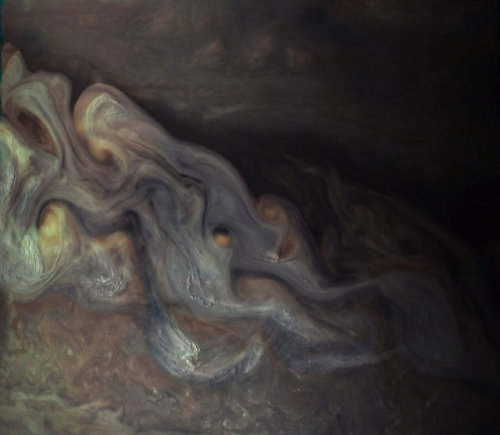
A close-up of an enhanced-color image of Jupiter’s clouds obtained by NASA’s Juno spacecraft.
NASA/SWRI/MSSS/Gerald Eichstädt/Seán Doran / New York Times
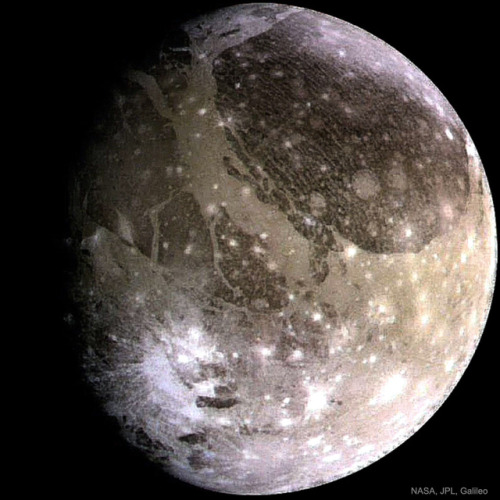
What does the largest moon in the Solar System look like? Jupiter’s moon Ganymede, larger than even Mercury and Pluto, has an icy surface speckled with bright young craters overlying a mixture of older, darker, more cratered terrain laced with grooves and ridges. The large circular feature on the upper right, called Galileo Regio, is an ancient region of unknown origin. Ganymede is thought to have an ocean layer that contains more water than Earth and might contain life. Like Earth’s Moon, Ganymede keeps the same face towards its central planet, in this case Jupiter. The featured image was taken about 20 years ago by NASA’s Galileo probe, which ended its mission by diving into Jupiter’s atmosphere in 2003. Currently, NASA’s Juno spacecraft orbits Jupiter and is studying the giant planet’s internal structure, among many other attributes. Image Credit: NASA, JPL, Galileo Probe
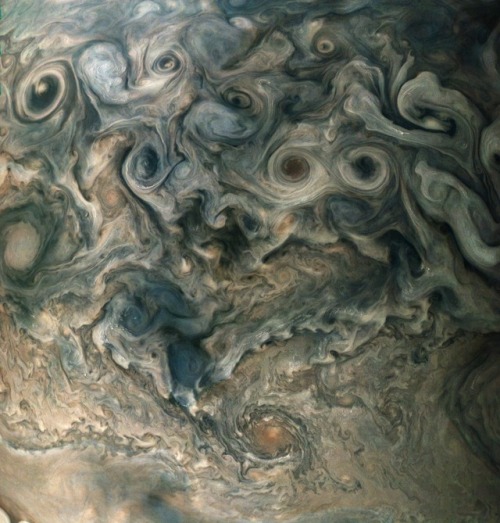
An image of the North polar region of Jupiter.
Taken by NASA’s spacecraft Juno.
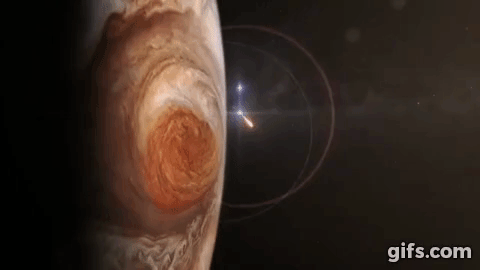
Infrared Jupiter looks hot as Juno spacecraft approaches
NASA’s mission to explore the Jovian system has almost reached its destination, and telescopes on Earth are capturing some especially fiery images of the planet to help.

Breathtaking views just keep coming! At a distance of 63,400 miles above the cloud tops of Jupiter’s South Pole, the Juno spacecraft reveals incredibly detailed views of the planet’s powerful cyclones and storms.
(Image credit: NASA / MSSS / SwRI / JPL / Caltech. Reprocessing Roman Tkachenko)
Jupiter and beyond the Infinite…
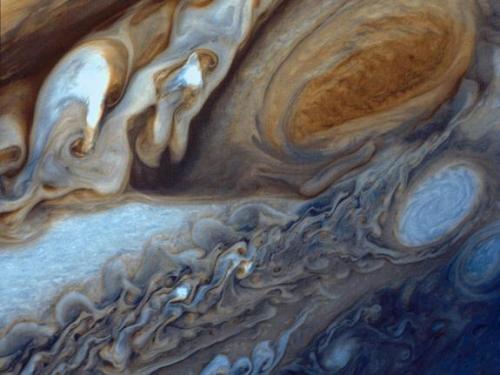
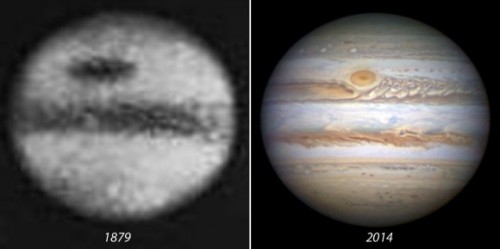
Will Jupiter’s Great Red Spot turn into a wee red dot? by BOB KING
Watch out! One day it may just go away. Jupiter’s most celebrated atmospheric beauty mark, the Great Red Spot (GRS), has been shrinking for years. When I was a kid in the ’60s peering through my Edmund 6-inch reflector, not only was the Spot decidedly red, but it was extremely easy to see. Back then it really did span three Earths. Not anymore.
In the 1880s the GRS resembled a huge blimp gliding high above white crystalline clouds of ammonia and spanned 40,000 km (25, 000 miles) across. You couldn’t miss it even in those small brass refractors that were the standard amateur observing gear back in the day. Nearly one hundred years later in 1979, the Spot’s north-south extent has remained virtually unchanged, but it’s girth had shrunk to 25,000 km (15,535 miles) or just shy of two Earth diameters. Recent work done by expert astrophotographer Damian Peach using the WINJUPOS program to precisely measure the GRS in high resolution photos over the past 10 years indicates a continued steady shrinkage:
2003 Feb – 18,420km (11,445 miles)
2005 Apr – 18,000km (11,184)
2010 Sep – 17,624km (10,951)
2013 Jan – 16,954km (10,534)
2013 Sep – 15,894km (9,876)
2013 Dec – 15,302km (9,508) = 1.2 Earth diameters
If these figures stand up to professional scrutiny, it make one wonder how long the spot will continue to be a planetary highlight. It also helps explain why it’s become rather difficult to see in smaller telescopes in recent years. Yes, it’s been paler than normal and that’s played a big part, but combine pallor with a hundred-plus years of downsizing and it’s no wonder beginning amateur astronomers often struggle to locate the Spot in smaller telescopes. This observing season the Spot has developed a more pronounced red color, but unless you know what to look for, you may miss it entirely unless the local atmospheric seeing is excellent.
Not only has the Spot been shrinking, its rotation period has been speeding up. Older references give the period of one rotation at 6 days. John Rogers (British Astronomical Assn.) published a 2012 paper on the evolution of the GRS and discovered that between 2006 to 2012 – the same time as the Spot has been steadily shrinking – its rotation period has spun up to 4 days. As it shrinks, the storm appears to be conserving angular momentum by spinning faster the same way an ice skater spins up when she pulls in her arms.
Rogers also estimated a max wind speed of 300 mph, up from about 250 mph in 2006. Despite its smaller girth, this Jovian hurricane’s winds pack more punch than ever. Even more fascinating, the Great Red Spot may have even disappeared altogether from 1713 to 1830 before reappearing in 1831 as a long, pale “hollow”. According to Rogers, no observations or sketches of that era mention it. Surely something so prominent wouldn’t be missed. This begs the question of what happened in 1831. Was the “hollow” the genesis of a brand new Red Spot unrelated to the one first seen by astronomer Giovanni Cassini in 1665? Or was it the resurgence of Cassini’s Spot?
Clearly, the GRS waxes and wanes but exactly what makes it persist? By all accounts, it should have dissipated after just a few decades in Jupiter’s turbulent environment, but a new model developed by Pedram Hassanzadeh, a postdoctoral fellow at Harvard University, and Philip Marcus, a professor of fluid dynamics at the University of California-Berkeley, may help to explain its longevity. At least three factors appear to be at play:
* Jupiter has no land masses. Once a large storm forms, it can sustain itself for much longer than a hurricane on Earth, which plays itself out soon after making landfall.
* Eat or be eaten: A large vortex or whirlpool like the GRS can merge with and absorb energy from numerous smaller vortices carried along by the jet streams.
* In the Hassanzadeh and Marcus model, as the storm loses energy, it’s rejuvenated by vertical winds that transport hot and cold gases in and out of the Spot, restoring its energy. Their model also predicts radial or converging winds within the Spot that suck air from neighboring jet streams toward its center. The energy gained sustains the GRS.
If the shrinkage continues, “Great” may soon have to be dropped from the Red Spot’s title. In the meantime, Oval BA (nicknamed Red Spot Jr.) and about half the size of the GRS, waits in the wings. Located along the edge of the South Temperate Belt on the opposite side of the planet from the GRS, Oval BA formed from the merger of three smaller white ovals between 1998 and 2000. Will it give the hallowed storm a run for its money? We’ll be watching.
At left, photo of Jupiter’s enormous Great Red Spot in 1879 from Agnes Clerk’s Book ” A History of Astronomy in the 19th Century”. At right, Jupiter on Jan. 10, 2014. Credit: Damian Peach

On April 21, 2014, the Hubble telescope captured what looks like a black hole in Jupiter’s Great Red Spot — but really, it’s the shadow of the Jovian moon Ganymede. (Source)
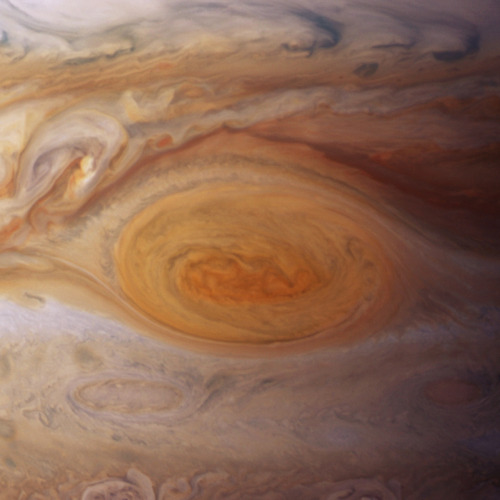

Jupiter’s Great Red Spot is such a crazy, turbulent storm (the largest known storm in the universe) that it creates sound waves that travel hundreds of miles up and actually heat the planet’s upper atmosphere.
I repeat: sound waves are heating Jupiter’s atmosphere. The area above the Spot is a thousand degrees Fahrenheit hotter than the surrounding atmosphere.
Here’s the journal paper. Here’s our story.
Image credit: Space Telescope Science Institute/NASA

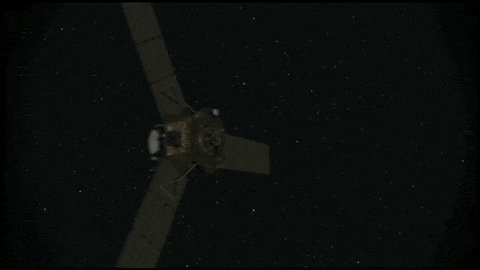
NASA‘s Juno: spacecraft has successfully entered orbit around the gas giant Jupiter.
After five years and 1.7 billion miles the probe accomplish a risky braking manoeuvre in order for it to be hooked by Jupiter’s gravity. NASA’s Jet Propulsion Laboratory, California received the confirmation signal which confirmed Juno had finally entered orbit on July 4. Juno will begin a two-year mission of discovery which will help scientists better understand one of the largest objects in our solar system.
Using Juno’s complex array of cameras and sensors the team hope to answer some long-awaited questions including whether Jupiter actually has a solid core or if it really is just a swirling ball of gas. Another focus will be the Great Red Spot - a massive storm several times the size of Earth that has been raging on the surface of Jupiter for what appears to be hundreds of years. Juno is the fastest spacecraft to ever enter orbit around a planet, travelling at an astonishing 130,000mph by the time it reached the gas giant.
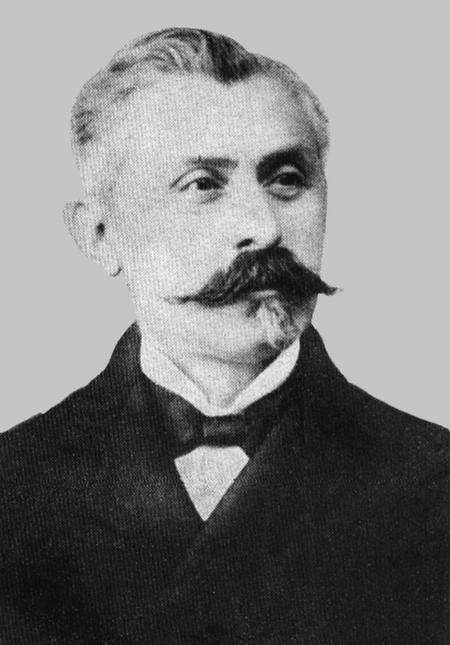
Սպիրու Կոստաքեի Հարեթ Spiru C. Haret
Romanian Armenian mathematician, astronomer and politician. He made a fundamental contribution to the n-body problem in celestial mechanics by proving that using a third degree approximation for the disturbing forces implies instability of the major axes of the orbits, and by introducing the concept of secular perturbations in relation to this. (Proved that planetary motion is not absolutely stable) As a politician, during his three terms as Minister of Education, Haret ran deep reforms, building the modern Romanian education system. He was made a full member of the Romanian Academy in 1892. He also founded the Astronomical observatory in Bucharest, The crater Haret on the Moon is named after him. The Spiru Haret University, a private university in Bucharest, Romania, bears the name of a scientist and reformer of the Romanian education.
Born 15 February 1851 in Iaşi, Moldavia to an Armenian family, He showed talent for mathematics at a very young age, publishing two textbooks, one in algebra and one in trigonometry when he was still in high school. Whilst in his second year studying physics and mathematics the in the University of Bucharest, he became a teacher of mathematics in Nifon Seminary.
After graduation, Haret won a scholarship competition organized by Titu Maiorescu and went to Paris in order to study mathematics at the Sorbonne. There he earned a mathematics diploma in 1875 and a physics diploma in 1876. Two years later he earned his Ph.D. by defending his thesis, Sur l’invariabilité des grandes axes des orbites planétaires (On the invariability of the major axis of planetary orbits), in front of examiners led by Victor Puiseux. In this work he proved a result fundamental for the n-body problem in astronomy, the thesis being published in Vol. XVIII of the Annales de l'Observatoire de Paris. Haret was the first Romanian to obtain a Ph.D. degree in Paris, (though he was of full Armenian descent)
After his return to Romania in 1878, Haret abandoned scientific research and dedicated the rest of his life to improving Romanian education, which was heavily underdeveloped at the time, both as professor and as politician. He only published an article on the secular acceleration of the Moon in 1880 and one on Jupiter’s Great Red Spot (1912). And in In 1910 he published Social mechanics, which used mathematics to explain social behaviour (somehow anticipating the fictional “psychohistory” branch of mathematics developed by Hari Seldon, the fictional character of Isaac Asimov‘s Foundation, published 40 years later).
He was appointed professor of rational mechanics at the Science Faculty in Bucharest. The next year Haret became a correspondent member of the Romanian Academy. He kept the professorship at the Science Faculty until his retirement in 1910. As Minister of Education he ran a complete reform, basically building the modern Romanian education system
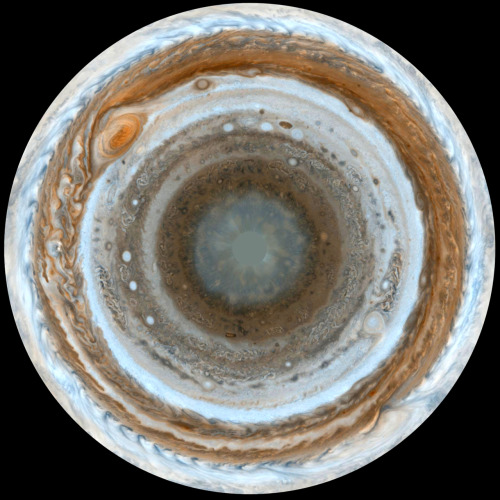
Map of Jupiter’s South
This map of Jupiter is the most detailed global color map of the planet ever produced. The round map is a polar stereographic projection that shows the south pole in the center of the map and the equator at the edge. It was constructed from images taken by Cassini on Dec. 11 and 12, 2000, as the spacecraft neared Jupiter during a flyby on its way to Saturn. The map shows a variety of colorful cloud features, including parallel reddish-brown and white bands, the Great Red Spot, multi-lobed chaotic regions, white ovals and many small vortices. Many clouds appear in streaks and waves due to continual stretching and folding by Jupiter’s winds and turbulence. The bluish-gray features along the north edge of the central bright band are equatorial “hot spots,” meteorological systems such as the one entered by NASA’s Galileo probe. Small bright spots within the orange band north of the equator are lightning-bearing thunderstorms. The polar region shown here is less clearly visible because Cassini viewed it at an angle and through thicker atmospheric haze. Image Credit: NASA/JPL/Space Science Institute
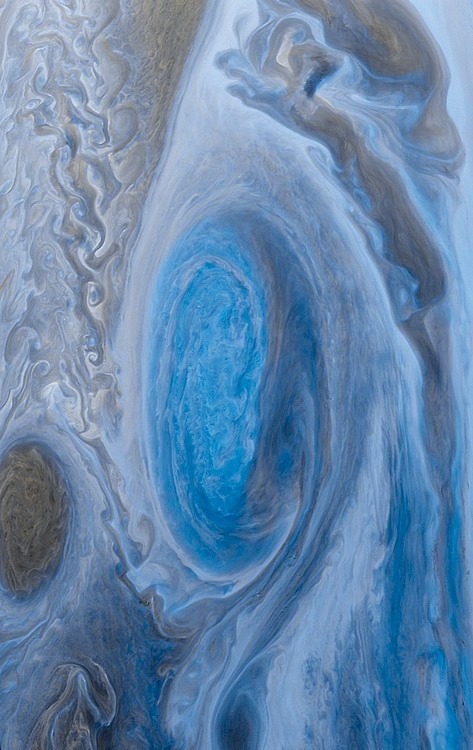
Jupiter’s Great Red Spot from Voyager 1 Color Inverted
What will become of Jupiter’s Great Red Spot? Recorded as shrinking since the 1930s, the rate of the Great Red Spot’s size appears to have accelerated just in the past few years. A hurricane larger than Earth, the Great Red Spot has been raging at least as long as telescopes could see it. Like most astronomical phenomena, the Great Red Spot was neither predicted nor immediately understood after its discovery. Although small eddies that feed into the storm system seem to play a role, a more full understanding of the gigantic storm cloud remains a topic of continued research, and may result in a better understanding of weather here on Earth. The above image is a digital enhancement of an image of Jupiter taken in 1979 by the Voyager 1 spacecraft as it zoomed by the Solar System’s largest planet. NASA’s Juno spacecraft is currently heading toward Jupiter and will arrive in 2016.
Image Credit: NASA, JPL; Digital processing: Björn Jónsson (IAAA), Color: thedemon-hauntedworld

Jupiter. The king of our solar system. It might not be the greatest picture ever taken of Jupiter but at least I get to call it mine! You can even make out Jupiter’s great red spot, a storm so big that it could engulf Earth 3 times over!
Experiment resolves mystery about wind flows on Jupiter
Using a spinning table and a massive garbage can, geophysicist leads team in simulating the planet’s atmosphere
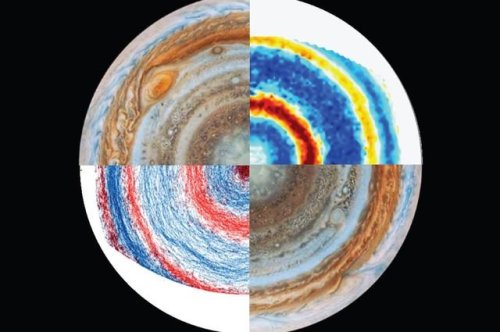
One mystery has been whether the jets exist only in the planet’s upper atmosphere – much like Earth’s own jet streams – or whether they plunge into Jupiter’s gaseous interior. If the latter is true, it could reveal clues about the planet’s interior structure and internal dynamics.
Now, UCLA geophysicist Jonathan Aurnou and collaborators in Marseille, France, have simulated Jupiter’s jets in the laboratory for the first time. Their work demonstrates that the winds likely extend thousands of miles below Jupiter’s visible atmosphere.
This research is published online in Nature Physics.
Keep reading
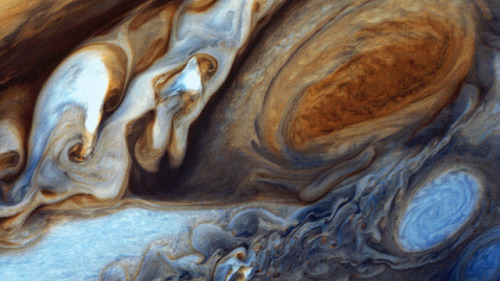
Jupiter’s Great Red Spot as Viewed by Voyager 1 in February, 1979. The Great Red Spot is an anticyclone, three and a half times the size of Earth located in Jupiter’s southern hemisphere. [1920 × 1080]
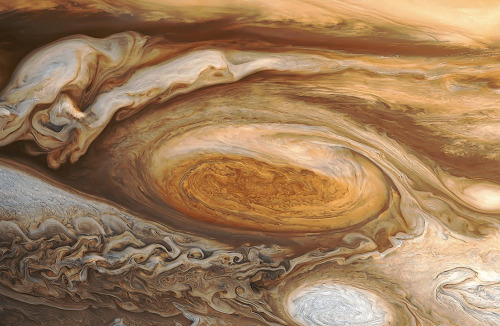
The Great Red Spot
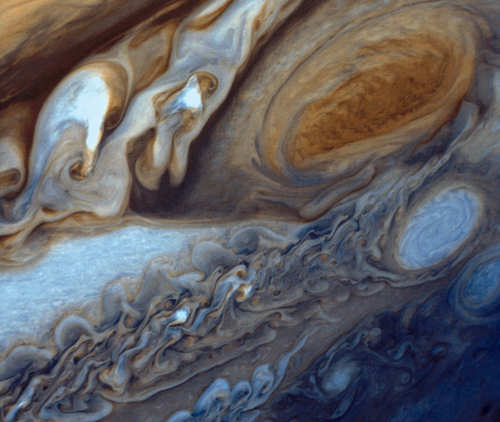
Jupiter’s swirling clouds around the Great Red Spot. NASA/JPL.
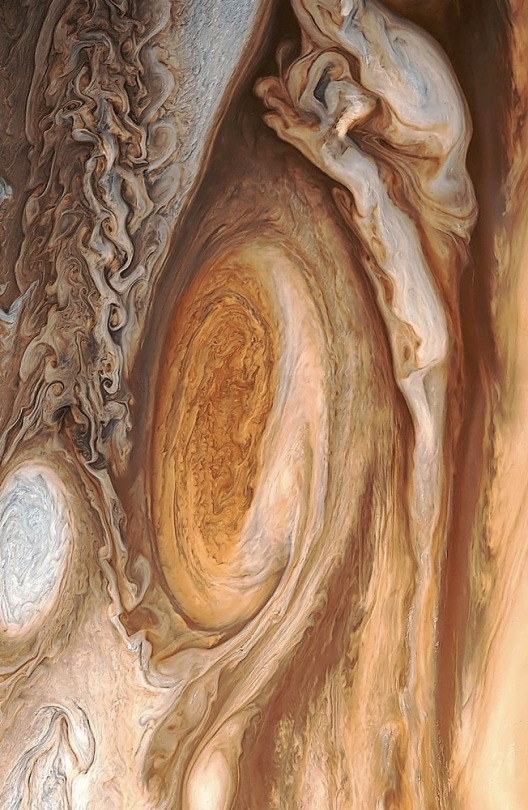
Great Red Spot of Jupiter

Jupiter
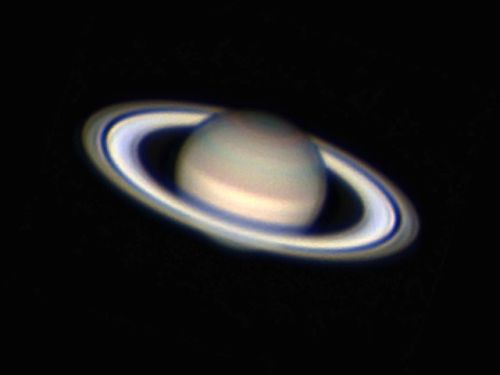
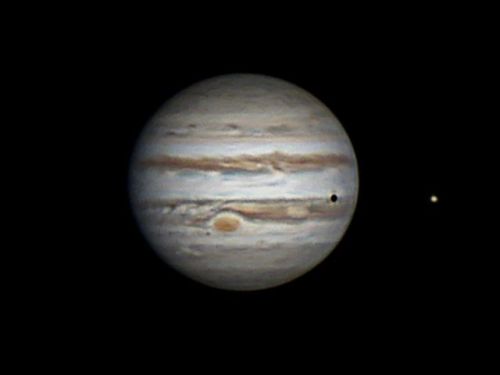
Saturn and Jupiter You can see Jupiter’s moon, Io, casting a shadow onto the gas giant. Credit and Source: nomorelickfoot
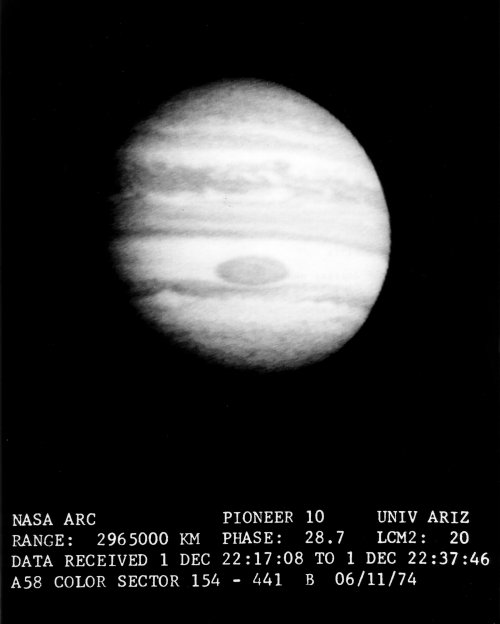
This view of Jupiter shows the giant planet’s cloud tops taken by the Pioneer 10 spacecraft as it flew past Jupiter. This view was taken from 2,695,000 kilometers (1,842,451 miles) away. It shows the 25,000 mile long Great Red Spot, which is large enough to swallow up several Earths. Individual cloud formations are visible in some detail. The bright zones appear to become split up into the detailed flow patterns of Jupiter’s atmosphere and clouds. The area surrounding the Spot in the bright South Tropical Zone, suggests a flow pattern about the Spot which is bulged toward the north by the Spot. The Spot may be a gigantic “permanent hurricane.” The gigantic cloud swirls are thousands or more miles across. Pioneer 10 flew past Jupiter in December 1974 and flew past the orbit of Pluto in 1987. A sister spacecraft, Pioneer 11 reached Jupiter in December 1975. The Pioneer Project was managed by NASA’s Ames Research Center, Mountain View, Calafornia. The spacecraft was built by TRW Systems.
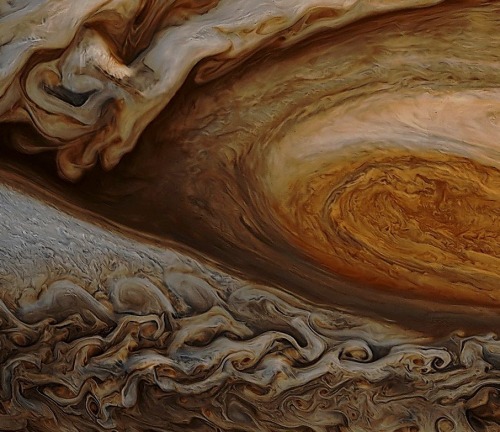
Great Red Spot closeup
via reddit
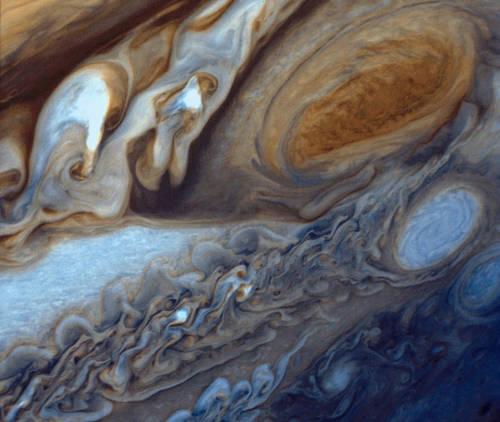
Jupiter’s Great Red Spot Viewed by Voyager 1
At about 89,000 miles in diameter, Jupiter could swallow 1,000 Earths. It is the largest planet in the solar system and perhaps the most majestic. Vibrant bands of clouds carried by winds that can exceed 400 mph continuously circle the planet’s atmosphere. Such winds sustain spinning anticyclones like the Great Red Spot – a raging storm three and a half times the size of Earth at the time of this photo, located in Jupiter’s southern hemisphere. In January and February 1979, NASA’s Voyager 1 spacecraft zoomed toward Jupiter, capturing hundreds of images during its approach, including this close-up of swirling clouds around Jupiter’s Great Red Spot.
Credit: NASA’s Goddard Space Flight Center
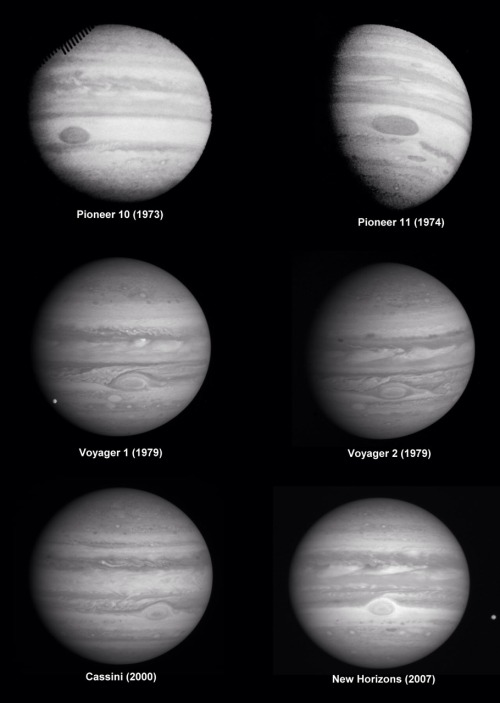
Jupiter as seen by six different spacecraft.
NASA / JPL / SSI / JHUAPL / SwRI / Björn Jónsson
tfw your inactive blog gets a whole bunch of notes out of nowhere and you wonder if you could ever bring it back to life

The first Space Launch System hardware from NASA’s Michoud Assembly Facility in New Orleans just arrived at NASA’s Marshall Space Flight Center in Huntsville, Alabama. We take a minute to introduce you to the crew of NASA’s barge Pegasus. The crew made an 18-day journey on the barge leaving New Orleans on April 28 and arriving at Marshall on May 15. The barge delivered a structural test version of the core stage engine section of SLS, NASA’s new heavy-lift rocket. Pegasus will deliver four test articles of the rocket’s core stage to Marshall for tests that will simulate the forces experienced during launch. Pegasus will later ferry the flight-ready core stage to NASA’s Stennis Space Center near Bay St. Louis, Mississippi, for testing and then to NASA’s Kennedy Space Center in Florida for integration of the SLS flight vehicle in the Vehicle Assembly Building.
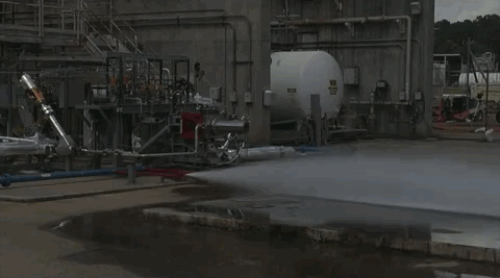
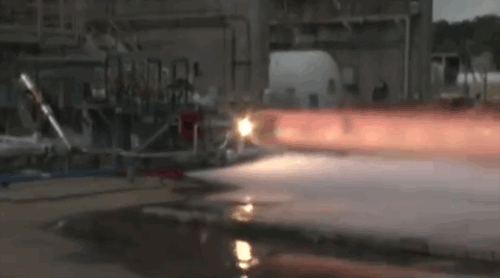
NASA Tests 3-D Printed Engine Components
3-D printing isn’t just for toys and plastic models of your head. Witness a hot fire of NASA’s newest design for rocket engine injectors, 3-D printed to up performance in a way that traditional manufacturing of the parts couldn’t attain.
The agency, which tested the experimental injectors last month at Marshall Space Flight Center in Huntsville, Ala., used a type of 3-D printing called direct laser melting. To make the parts, a machine fires a laser at metal powder under the direction of a computer design program. This deposits layers of the metal one on top of the other until the part is complete.
NASA says the technique is letting engineers build the injector out of just two parts instead of the 163 formerly needed using traditional manufacturing methods.
Keep reading